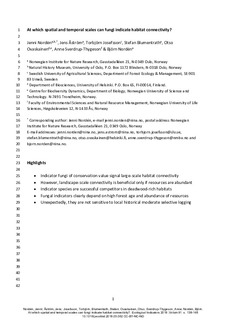| dc.contributor.author | Nordén, Jenni | |
| dc.contributor.author | Åström, Jens | |
| dc.contributor.author | Josefsson, Torbjörn | |
| dc.contributor.author | Blumentrath, Stefan | |
| dc.contributor.author | Ovaskainen, Otso | |
| dc.contributor.author | Sverdrup-Thygeson, Anne | |
| dc.contributor.author | Nordén, Björn | |
| dc.date.accessioned | 2018-04-10T08:22:14Z | |
| dc.date.available | 2018-04-10T08:22:14Z | |
| dc.date.created | 2018-04-09T09:31:03Z | |
| dc.date.issued | 2018 | |
| dc.identifier.citation | Ecological Indicators. 2018, 91 138-148. | nb_NO |
| dc.identifier.issn | 1470-160X | |
| dc.identifier.uri | http://hdl.handle.net/11250/2493342 | |
| dc.description.abstract | Isolation of habitats in space and time affects species globally and in a multitude of ecosystems. It is however often difficult to assess the level of isolation from the point of view of the focal species. Indicator species are often used to assess ‘conservation value’ of habitats. One such approach involves the use of wood-decaying fungal species as indicators of near-natural forests, continuity in old-forest characteristics over time, and/or presence of red-listed species, but not of spatial connectivity. The indicator species were commonly assigned based on expert opinions, but few scientific evaluations have been performed of what these species actually indicate. Building on previous classifications of wood-decaying fungal indicator species on Norway spruce, we hypothesized that indicator species would differ from non-indicator species in how they respond to local temporal connectivity (forest age, the intensity of historical selective logging and the presence of well-decomposed large logs), and to local and landscape-scale spatial connectivity (local forest area, local amount of deadwood and the connectivity to old forest in the surrounding landscape). Based on fungal occurrence data from a fixed number of spruce logs at 28 sites distributed across the Scandinavian Peninsula, we explored the spatiotemporal scales at which the local communities were affected by connectivity. Indicator species showed the strongest response to connectivity of old forest (≥80 years) within 100 km, while non-indicator species depended on connectivity of younger forest (≥40 years) at a smaller spatial scale (≤25 km). Indicator species increased and non-indicator species decreased in total abundance with the increasing age of the local forest stand. Landscapescale old-forest connectivity was beneficial for indicator species in all sites except those with relatively low amount of deadwood, while non-indicator species showed the opposite pattern. We identify a threshold of around 29m3 ha−1 in the amount of spruce logs where indicator species become abundant enough to influence non-indicator species through competitive interactions. There was a pronounced uniformity within each species group in the connectivity responses. We conclude that the studied indicator species indicate high forest age, high amount of resources and, given that the resources are plentiful, also high old-forest connectivity, but they do not indicate a long history without any logging operations or local deadwood continuity. The studied non-indicator species did not indicate any of the studied spatiotemporal connectivity variables. Indicator species are usually red-listed and may continue to decline in the future without habitat restoration efforts. Habitat fragmentation Continuity Deadwood Basidiomycetes Red-listed species Logging history | nb_NO |
| dc.language.iso | eng | nb_NO |
| dc.publisher | Elsevier | nb_NO |
| dc.rights | Attribution-NonCommercial-NoDerivatives 4.0 Internasjonal | * |
| dc.rights.uri | http://creativecommons.org/licenses/by-nc-nd/4.0/deed.no | * |
| dc.title | At which spatial and temporal scales can fungi indicate habitat connectivity? | nb_NO |
| dc.type | Journal article | nb_NO |
| dc.type | Peer reviewed | nb_NO |
| dc.description.version | acceptedVersion | nb_NO |
| dc.subject.nsi | VDP::Zoologiske og botaniske fag: 480 | nb_NO |
| dc.subject.nsi | VDP::Zoology and botany: 480 | nb_NO |
| dc.source.pagenumber | 138-148 | nb_NO |
| dc.source.volume | 91 | nb_NO |
| dc.source.journal | Ecological Indicators | nb_NO |
| dc.identifier.doi | 10.1016/j.ecolind.2018.03.062 | |
| dc.identifier.cristin | 1578238 | |
| dc.relation.project | Norges forskningsråd: 203808 | nb_NO |
| dc.relation.project | Egen institusjon: Norwegian Institute for Nature Research (NINA) | nb_NO |
| dc.relation.project | Andre: Academy of Finland 137135 | nb_NO |
| dc.relation.project | Andre: Academy of Finland 250444 | nb_NO |
| dc.description.localcode | © 2018. This is the authors’ accepted and refereed manuscript to the article. Locked until 6.4.2020 due to copyright restrictions. This manuscript version is made available under the CC-BY-NC-ND 4.0 license http://creativecommons.org/licenses/by-nc-nd/4.0/ | nb_NO |
| cristin.unitcode | 194,63,15,0 | |
| cristin.unitname | Institutt for matematiske fag | |
| cristin.ispublished | true | |
| cristin.fulltext | postprint | |
| cristin.qualitycode | 1 | |

